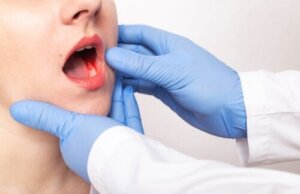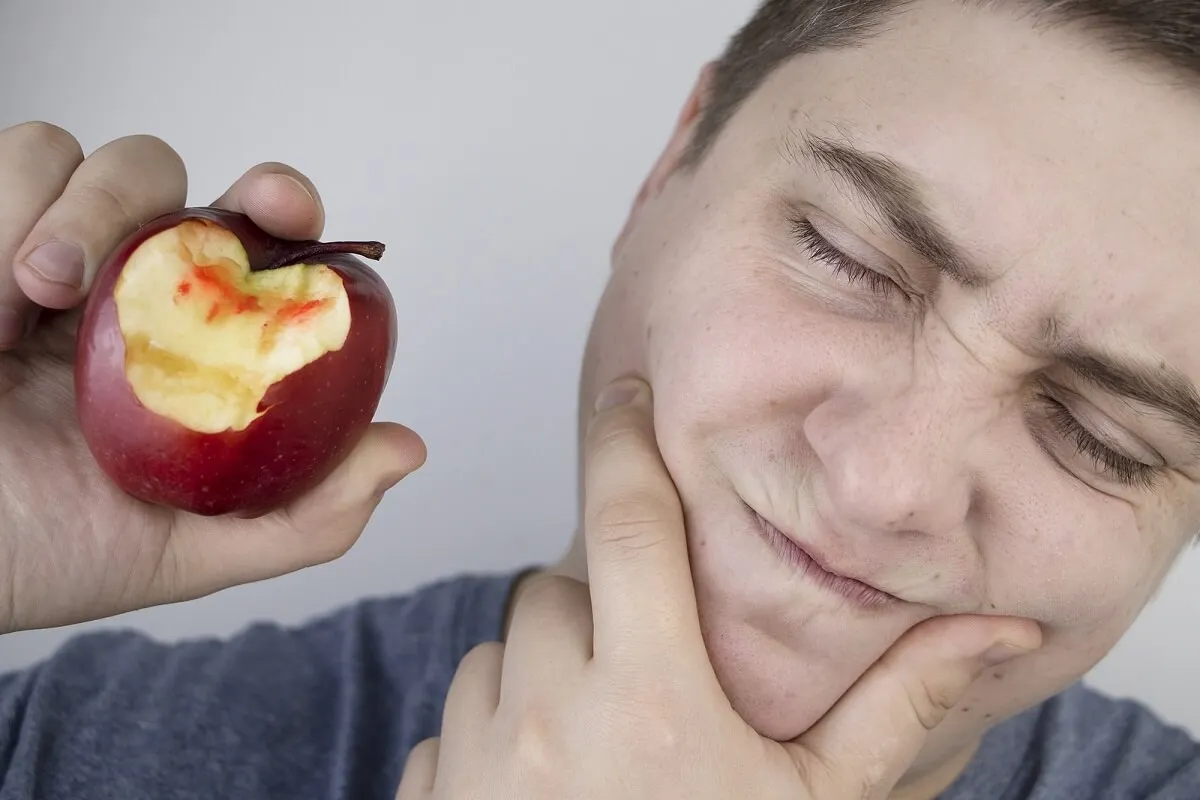The Symptoms and Causes of Periodontitis


Written and verified by the doctor Leonardo Biolatto
Knowing the symptoms and causes of periodontitis allows us to take preventive measures against this disease. In this way, we make an immediate consultation if we notice anything unusual in the gums. It shouldn’t be ignored that this disease can evolve into clinical presentations that complicate both our oral and general health.
Its origin is often the bacteria that accumulate between the teeth and gums. They manage to colonize the area when they multiply excessively. In this regard, as you will see in this article, hygiene plays a very important role as a preventive measure.
How does periodontitis evolve?
Periodontitis has symptoms that depend on the stage of evolution of the clinical picture. It’s not a disease that presents itself in a fixed manner or that always persists the same in the body.
The first thing that occurs is an inflammation of the gums, known as gingivitis. Usually, the person who suffers from it notices it when brushing his or her teeth and notices bleeding in the oral tissue when the toothbrush rubs against it.
Bacterial plaque may also be detected. This is a film adhered to the tooth surface containing bacteria and amalgamated food debris. It’s often called a biofilm, actually, because it has activity and is not inert – i.e. it’s constantly changing.
The next phase is the retraction of the gums. This exposes the lower parts of the tooth elements that are exposed to the outside. One of the problems of periodontitis at this stage is the hypersensitivity caused by the contact of the roots with cold, heat, and food.
If the evolution continues, the localized inflammation can spread, first to the rest of the mouth and then to the whole body. It’s known that the inflammatory process is not limited to the gums in some patients, triggering reactions in distant anatomical areas, such as the bones of the lower limbs.

We think you may also enjoy reading this article: LED Teeth Whitening: Advantages, Disadvantages, and Care
The symptoms of periodontitis
As we said, the symptoms and signs of periodontitis depend on the stage of its development in the person suffering from the disease. In any case, there are issues that are always common to everyone and every phase, such as bleeding gums.
This blood is bright red and appears after minimal trauma that, under normal conditions, is not detected. Brushing is the main causative agent, followed by bruxism or tooth clenching at night. It’s common for people with this disease to wake up in the morning with blood around their teeth.
Bad breath also derives from bacterial plaque and its constant activity. The remains of food retained there also ferment and continue a process of putrefaction that is expressed in halitosis.
Meanwhile, pain or sensitivity when chewing is related to the retraction of the gums. When the gums descend too much and move away from the dental element itself, the root is exposed. Then, hot drinks and very cold foods, such as ice cream, irritate the nerves that were not in contact with the rest of the mouth before.
In extreme cases, the teeth may fall out. If gum recession is excessive, periodontitis can lead to spontaneous tooth loss, when the fibrous support disappears.
The causes of the disease
The causes of periodontitis should refer to the formation of biofilm, which is bacterial plaque. Therefore, it’s not wrong to think that bacteria are the main protagonists of the problem, generated by poor hygiene in most cases.
The normal bacterial flora of the mouth is not malignant. On the contrary, it fulfills essential functions of regulation of the internal environment of the saliva and protection against external infectious and pathogenic agents. However, its imbalance leads to problems.
When there’s a bad toothbrushing technique or it’s not done with adequate frequency, bacteria multiply and colonize the dental walls. In addition to this, food debris is trapped by plaque.
When there is an accumulation of this over the years, the immune system responds by considering that there are harmful external agents. Then, the body mobilizes white blood cells to the gums to fight the problem, which leads to tissue inflammation and subsequent retraction.
The immediate complication is the formation of spaces between the tooth and the gum, due to the retraction. If left untreated, this causes more bacteria and food debris to settle there.
It’s also important to keep in mind that certain risk situations favor the appearance of periodontitis:
- Tobacco: Smokers have a much higher risk of the disease than the rest of the population.
- Hormonal changes: In women, especially during pregnancy and menopause, several systems are altered, which stimulates plaque formation and the immune response in the gums.
- Vitamin deficiency: Hypovitaminosis, particularly of vitamin C, is related to gum disease.

Like this article? You may also like to read: 6 Easy Home Remedies For Plaque on Your Teeth
When to consult a dentist
Periodontitis is a disease that needs to be treated by a professional. The earlier the approach is made, the easier it will be to contain complications. Therefore, you must be attentive when brushing your teeth in case you notice any bleeding. If blood appears on the toothbrush, it’s worth consulting a dentist. This may be the first sign of the onset of the disease.
Similarly, it’s a good idea to see a dentist if you wake up with swollen and red gums repeatedly in the morning after a night’s rest. In the case of detecting changes in the color of the tooth surface due to the presence of plaque, rather than trying to remove it by force, it’s necessary to have it checked by a professional. Sometimes, because we want to act at home, we damage the gums in an attempt to improve the situation. Don’t wait; see a dentist as soon as possible.
Our teeth are important because there’s no replacement for them when we’re adults. The ones we have should be with us for the rest of our lives.
All cited sources were thoroughly reviewed by our team to ensure their quality, reliability, currency, and validity. The bibliography of this article was considered reliable and of academic or scientific accuracy.
- Amaro, Ilusión Melina Romero, et al. “Consideraciones periodontales de la hipersensibilidad dentinaria-Revisión de la literatura.” Acta odontológica venezolana 56.1 (2018): 13-14.
- Ramos-García, V., E. M. Otero-Rey, and A. Blanco-Carrión. “Relación entre enfermedad periodontal y artritis reumatoide.” Avances en Periodoncia e Implantología Oral 28.1 (2016): 23-27.
- Herrera, David, et al. “La nueva clasificación de las enfermedades periodontales y periimplantarias.” Revista científica de la Sociedad Española de Periodoncia 1.9 (2018): 94-110.
- Duque, Andrés, and Carolina Tejada. “Halitosis: Un asunto del odontólogo (Halitosis: A matter of dentist).” CES Odontología 29.1 (2016): 70-81.
- Soares, Renata de Souza Coelho, et al. “Movilidad dentaria en la periodontitis crónica.” Acta odontológica venezolana 49.4 (2011): 21-22.
- Guilarte, Carolina, and Marianella Perrone. “Bacterias Periodontopatógenas: Bacilos Anaerobios gran negativos como agentes Etiológicos de la Enfermedad Periodontal.” Acta Odontológica Venezolana 43.2 (2005): 198-204.
- Poyato Ferrera, Manuel María, et al. “La placa bacteriana: Conceptos básicos para el higienista bucodental.” Periodoncia, 11 (2), 149-164 (2001).
- Rojas, Javier Patricio, L. A. Rojas, and R. Hidalgo. “Tabaquismo y su efecto en los tejidos periodontales.” Revista clínica de periodoncia, implantología y rehabilitación oral 7.2 (2014): 108-113.
- Schlafer, Sebastian, et al. “Filifactor alocis-involvement in periodontal biofilms.” BMC microbiology 10.1 (2010): 1-13.
- Aguilar-Cordero, María José, et al. “La Enfermedad Periodontal como factor de riesgo de complicaciones durante el embarazo y parto.”
This text is provided for informational purposes only and does not replace consultation with a professional. If in doubt, consult your specialist.








